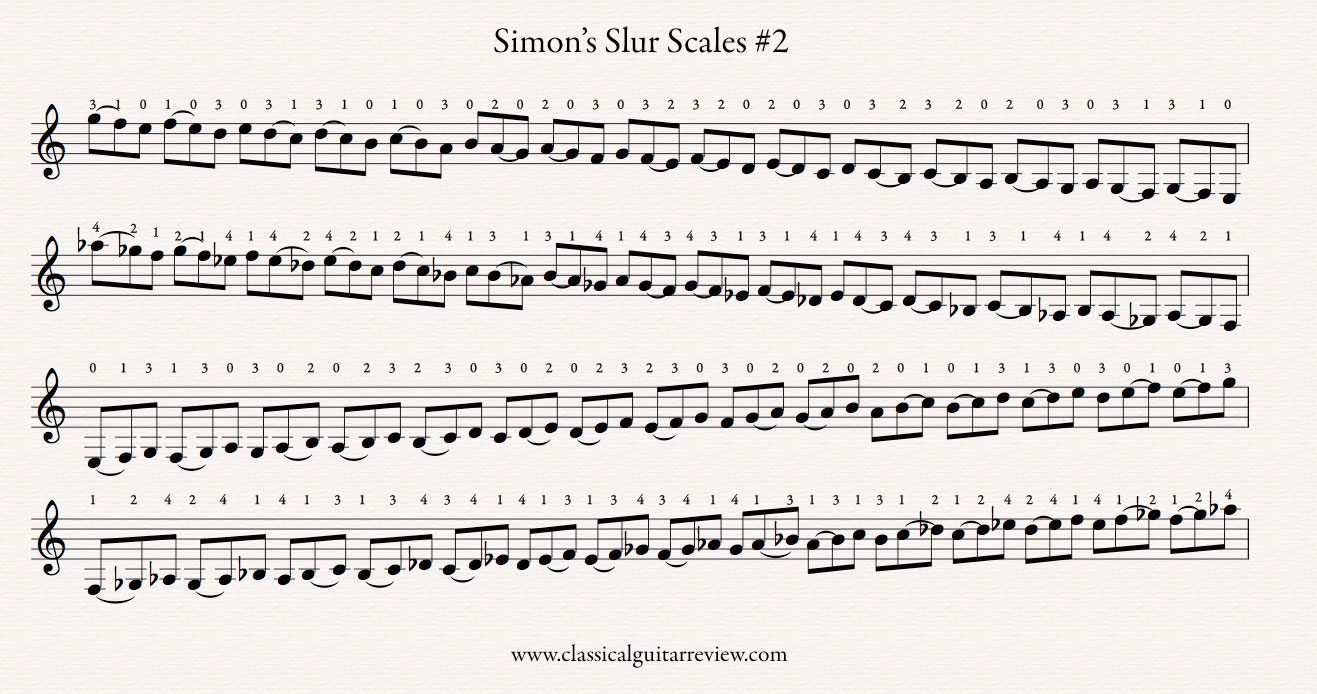Here are some slur scales that I came up with that really give a good work out to the left hand and also are quite fun to play!
You will notice that the scale takes on a pattern (except in first position) that can be repeated. Once you have completed one slur scale, shift the pattern up one fret and repeat the process. Be careful not to wear your hand out because slurs can be very tiring on those weenie left hand muscles and tendons. If you only want to do a few light repetitions you can start the patterns higher up the fretboard, around the seventh fret, as it will be easier than playing down in first position.
Focus on making a clean, crisp slur with a consistent snapping motion. After a while you will find that these scales start to flow nicely, at that point go and impress your girlfriend/boyfriend/attentive pet with your snappy slurry scales.
Rhythmic Variants
Scales are probably the first thing that comes to mind when we think of practice and technical development. The idea that practicing scales makes you a better musician seems to be universally accepted yet in the case of the classical guitar the ‘mythology’ of scale practice seems a little over-rated. Scales occur frequently in music written for violins, flutes and piano however, they come up rarely in the guitar repertoire. A full octave scale is actually quite hard to come by in much of the literature and when there is a long scale passage in a work it stands out partly because it is so rare. Violin and piano repertoire on the other hand is absolutely littered with virtuosic scale runs that span genres from the Baroque to the present day. It stands to reason, then, that we do not practice scales to be prepared for the occasional scale run in a piece.
The process of running up and down a scale, which is a very common way of practicing scales, is pointless.
So why do we practice scales ?
Scales are tools. They are simple frameworks that we can use to hone in on specific technical elements. Once those elements have been worked on in isolation they can be incorporated into music making, which is the ultimate goal of any technical work. Without a specific focus to practicing a scale then the time is wasted without any goals being reached. The scale itself may become familiar and fluid but seeing as there are few actual applications of a scale in a piece the process really is, pointless.
Scales are incredibly useful, however, if assigned a goal and function. One function might be to practice crescendo and diminuendo another could be to practice staccato articulations yet another is a variety of rhythms. As you may start to realize, the ways to use a scale to work on technical aspects is almost as diverse as your imagination. A more complete list of scale suggestions is written below and I encourage you to come up with your own uses for scale practice.
It could be argued that scales are useful for becoming acquainted with the fingerboard and learning key centers. This could be absolutely true although the common tendency to memorize scale ‘patterns’ on the guitar prevents any real development of these skills. If you doubt this, ask the next scale wiz that you come across to sight read some Bach ;)
Click here for Classical Guitar Scales
Here are some suggestions on how to apply your scales:
Dynamics
Crescendo
Diminuendo
Terraced Dynamics
pp,p,mp,mf,f,ff
Rhythms
Dotted Rhythms
Triplets with duplets
Groupings of 5,6,7
Tempo
Accellerando
Rallentando
Lento, Andante, Allegretto, Allegro, Presto etc.
Tone Control
Ponticello
Tasto
Extended Techniques
Pizzicato
Harmonics
Slurs
Articulations
Stacatto
Legato
Tenuto
Sforzando
Accents (place accents on different notes)
Right Hand Fingering
im, mi, ia, ai, ma, am, ami, mia, ima, pima, amip, pi, ip etc.
Left Hand Fingering
Shifts
Fixed fingers


Leave A Comment